Page 416 of 560
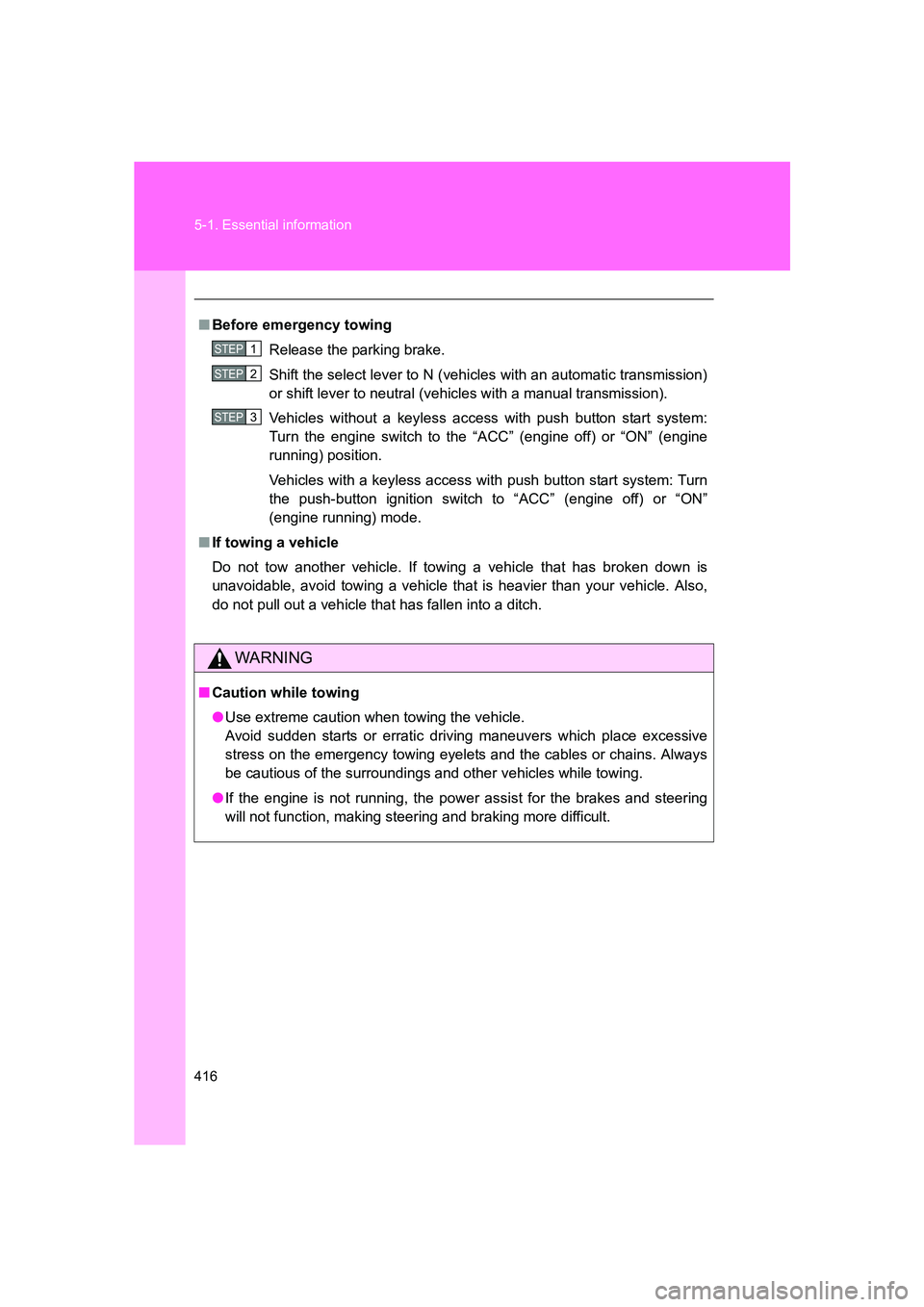
416 5-1. Essential information
BRZ_U
■Before emergency towing
Release the parking brake.
Shift the select lever to N (vehicles with an automatic transmission)
or shift lever to neutral (vehicles with a manual transmission).
Vehicles without a keyless access with push button start system:
Turn the engine switch to the “A CC” (engine off) or “ON” (engine
running) position.
Vehicles with a keyless access with push button start system: Turn
the push-button ignition switch to “ACC” (engine off) or “ON”
(engine running) mode.
■ If towing a vehicle
Do not tow another vehicle. If towing a vehicle that has broken down is
unavoidable, avoid towing a vehicle that is heavier than your vehicle. Also,
do not pull out a vehicle that has fallen into a ditch.
WARNING
■Caution while towing
●Use extreme caution when towing the vehicle.
Avoid sudden starts or erratic driving maneuvers which place excessive
stress on the emergency towing eyelets and the cables or chains. Always
be cautious of the surroundings and other vehicles while towing.
● If the engine is not running, the power assist for the brakes and steering
will not function, making steering and braking more difficult.
STEP 1
STEP 2
STEP 3
Page 417 of 560
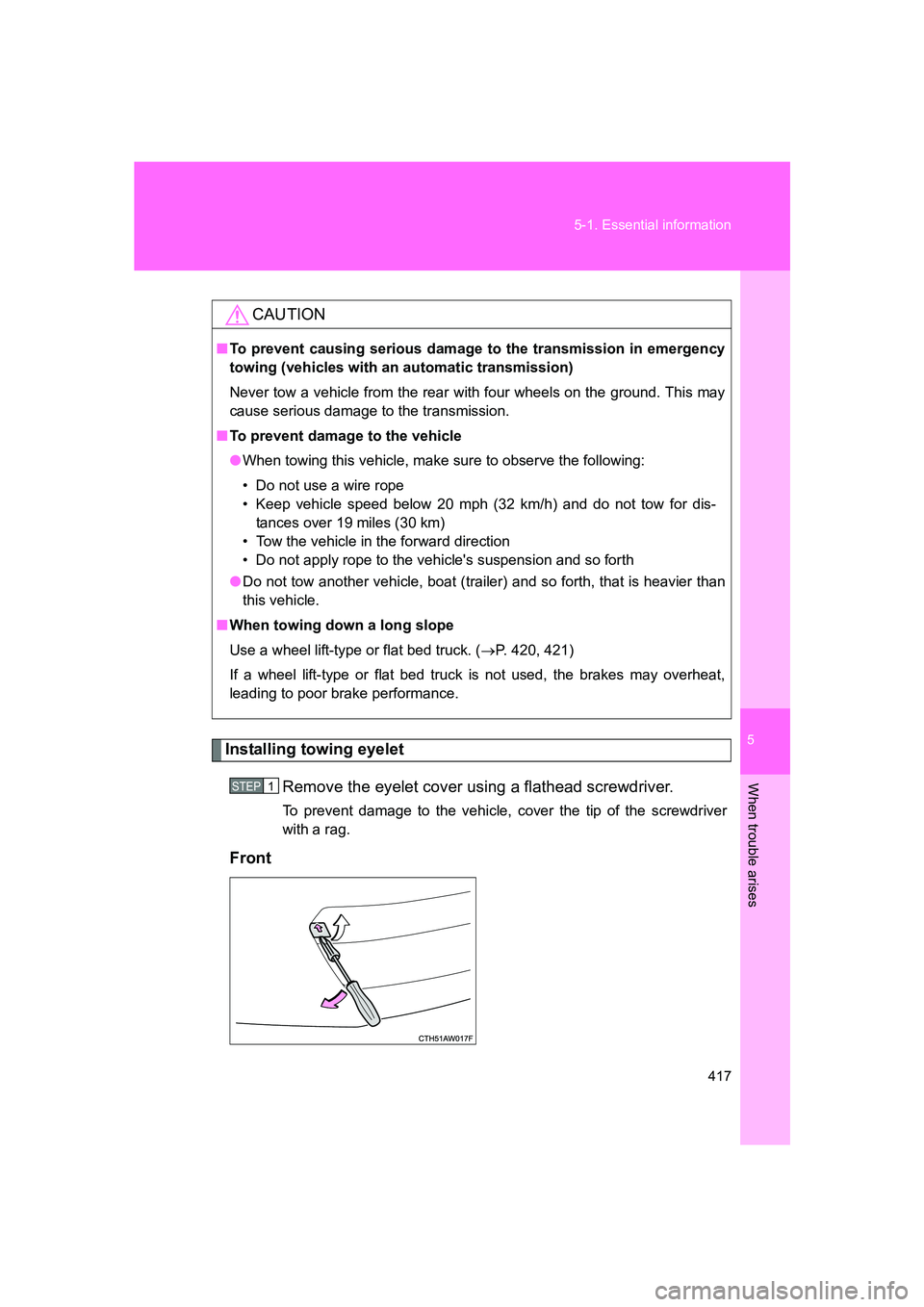
5
When trouble arises
417
5-1. Essential information
BRZ_U
Installing towing eyelet
Remove the eyelet cover using a flathead screwdriver.
To prevent damage to the vehicle, cover the tip of the screwdriver
with a rag.
Front
CAUTION
■To prevent causing serious damage to the transmission in emergency
towing (vehicles with an automatic transmission)
Never tow a vehicle from the rear with four wheels on the ground. This may
cause serious damage to the transmission.
■ To prevent damage to the vehicle
● When towing this vehicle, make sure to observe the following:
• Do not use a wire rope
• Keep vehicle speed below 20 mph (32 km/h) and do not tow for dis-
tances over 19 miles (30 km)
• Tow the vehicle in the forward direction
• Do not apply rope to the vehicle's suspension and so forth
● Do not tow another vehicle, boat (trailer) and so forth, that is heavier than
this vehicle.
■ When towing down a long slope
Use a wheel lift-type or flat bed truck. ( →P. 420, 421)
If a wheel lift-type or flat bed truck is not used, the brakes may overheat,
leading to poor brake performance.
STEP 1
Page 426 of 560
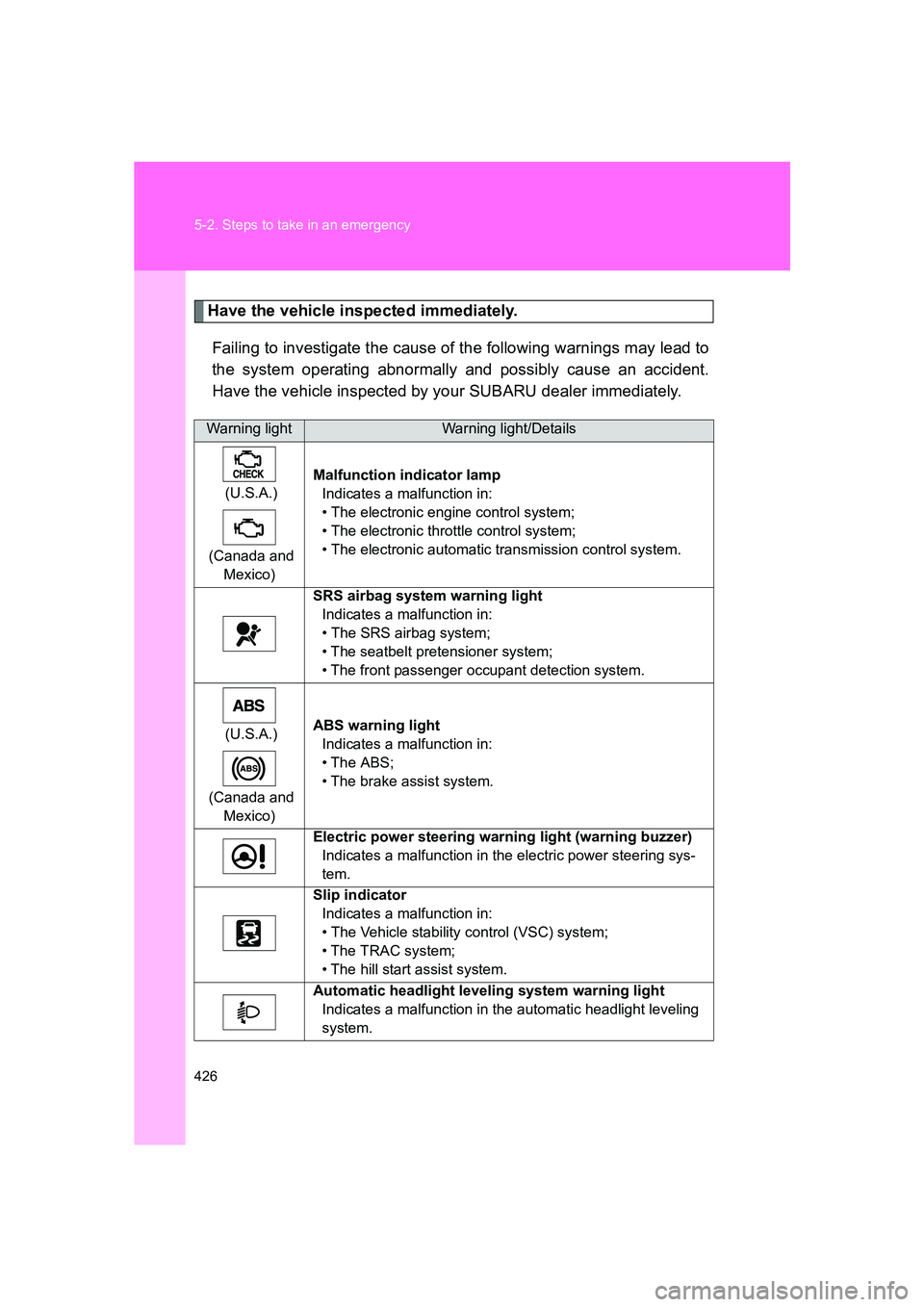
426 5-2. Steps to take in an emergency
BRZ_U
Have the vehicle inspected immediately.Failing to investigate the cause of the following warnings may lead to
the system operating abnormally and possibly cause an accident.
Have the vehicle inspected by your SUBARU dealer immediately.
Warning lightWarning light/Details
(U.S.A.)
(Canada and Mexico) Malfunction indicator lamp
Indicates a malfunction in:
• The electronic engine control system;
• The electronic throttle control system;
• The electronic automatic transmission control system.
SRS airbag system warning light Indicates a malfunction in:
• The SRS airbag system;
• The seatbelt pretensioner system;
• The front passenger occupant detection system.
(U.S.A.)
(Canada and Mexico) ABS warning light
Indicates a malfunction in:
• The ABS;
• The brake assist system.
Electric power steering warning light (warning buzzer) Indicates a malfunction in the electric power steering sys-
tem.
Slip indicator Indicates a malfunction in:
• The Vehicle stability control (VSC) system;
• The TRAC system;
• The hill start assist system.
Automatic headlight leveling system warning light Indicates a malfunction in the automatic headlight leveling
system.
Page 429 of 560
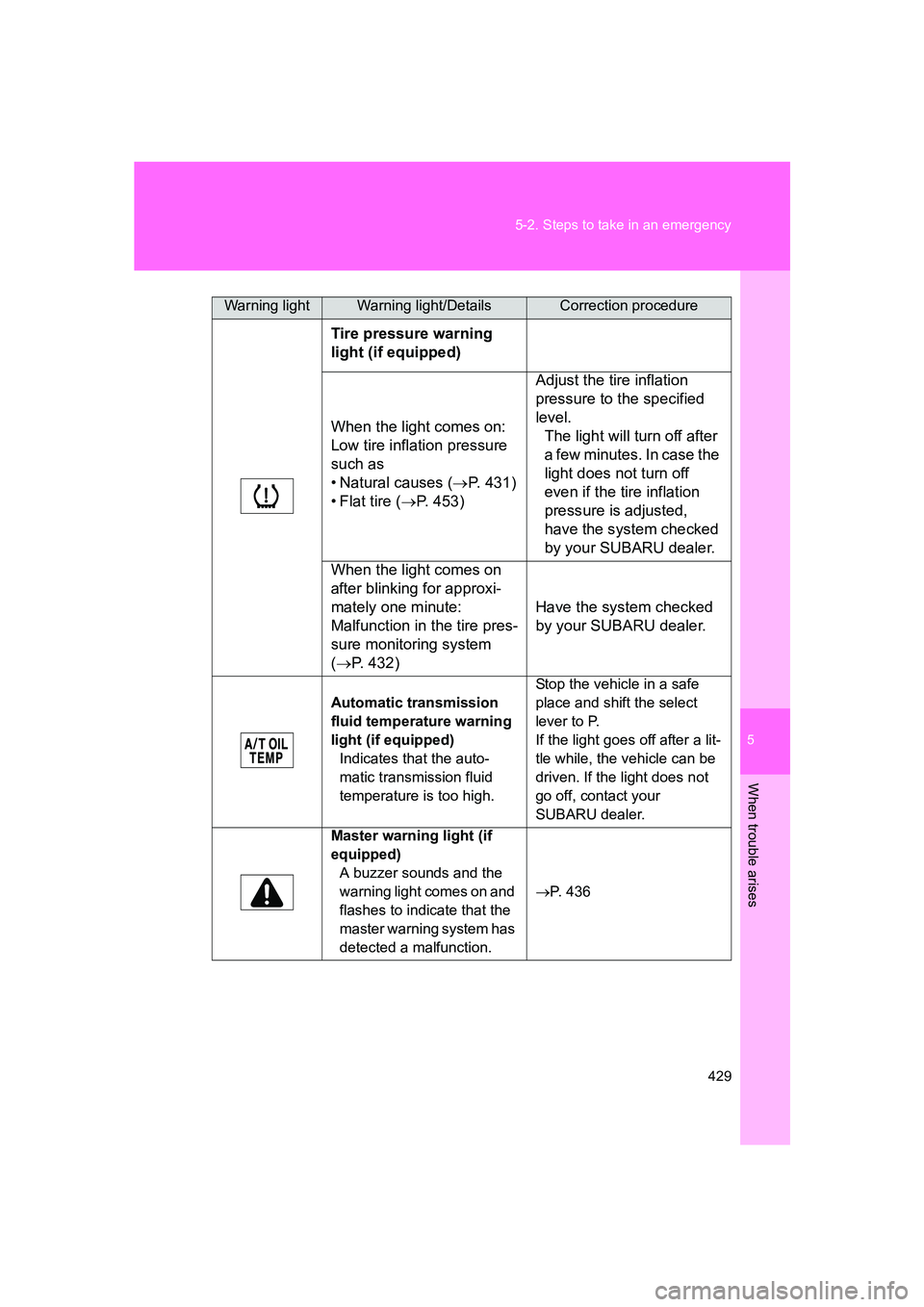
5
When trouble arises
429
5-2. Steps to take in an emergency
BRZ_U
Tire pressure warning
light (if equipped)
When the light comes on:
Low tire inflation pressure
such as
• Natural causes (
→P. 431)
• Flat tire ( →P. 453) Adjust the tire inflation
pressure to the specified
level.
The light will turn off after
a few minutes. In case the
light does not turn off
even if the tire inflation
pressure is adjusted,
have the system checked
by your SUBARU dealer.
When the light comes on
after blinking for approxi-
mately one minute:
Malfunction in the tire pres-
sure monitoring system
( → P. 432) Have the system checked
by your SUBARU dealer.
Automatic transmission
fluid temperature warning
light (if equipped)
Indicates that the auto-
matic transmission fluid
temperature is too high. Stop the vehicle in a safe
place and shift the select
lever to P.
If the light goes off after a lit-
tle while, the vehicle can be
driven. If the light does not
go off, contact your
SUBARU dealer.
Master warning light (if
equipped) A buzzer sounds and the
warning light comes on and
flashes to indicate that the
master warning system has
detected a malfunction. →
P. 436
Warning lightWarning light/DetailsCorrection procedure
Page 441 of 560
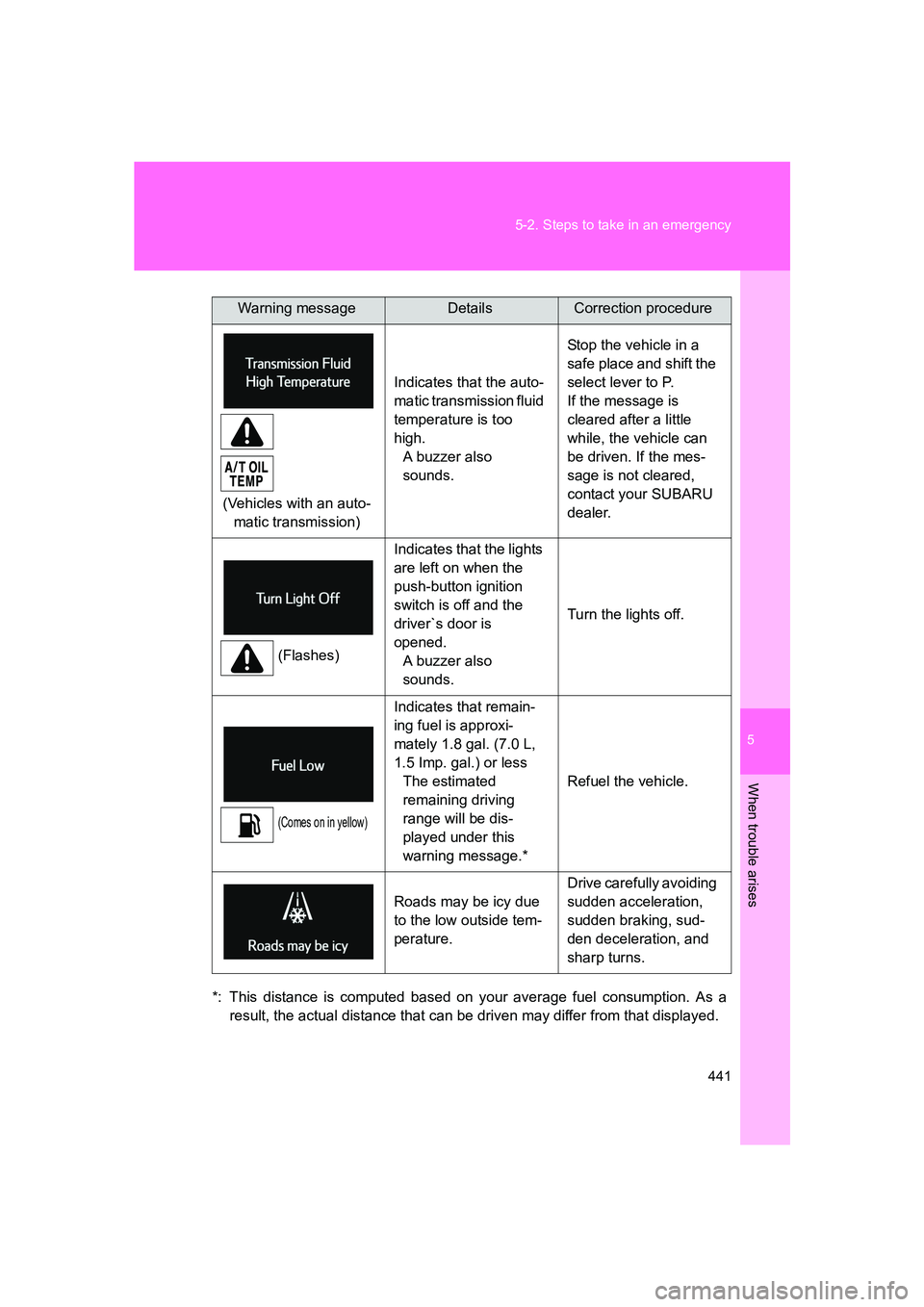
5
When trouble arises
441
5-2. Steps to take in an emergency
BRZ_U
*: This distance is computed based on your average fuel consumption. As a
result, the actual distance that can be driven may differ from that displayed.
(Vehicles with an auto-
matic transmission) Indicates that the auto-
matic transmission fluid
temperature is too
high.
A buzzer also
sounds. Stop the vehicle in a
safe place and shift the
select lever to P.
If the message is
cleared after a little
while, the vehicle can
be driven. If the mes-
sage is not cleared,
contact your SUBARU
dealer.
(Flashes) Indicates that the lights
are left on when the
push-button ignition
switch is off and the
driver`s door is
opened.
A buzzer also
sounds. Turn the lights off.
(Comes on in yellow)
Indicates that remain-
ing fuel is approxi-
mately 1.8 gal. (7.0 L,
1.5 Imp. gal.) or less
The estimated
remaining driving
range will be dis-
played under this
warning message.* Refuel the vehicle.
Roads may be icy due
to the low outside tem-
perature. Drive carefully avoiding
sudden acceleration,
sudden braking, sud-
den deceleration, and
sharp turns.
Warning messageDetailsCorrection procedure
Page 443 of 560
5
When trouble arises
443
5-2. Steps to take in an emergency
BRZ_U
Once3 times(Flashes)
(Flashes in yellow)
(Vehicles with an auto-
matic transmission) The access key
was carried out-
side the vehicle
and the driver’s
door was
opened and
closed while the
shift position P
was selected
without turning
off the push-but-
ton ignition
switch.
Turn the
push-but-
ton igni-
tion switch
off or bring
the access
key back
into the
vehicle.
Once
3 times(Flashes)
(Flashes in yellow)
(Vehicles with a manual transmission) The access key
was carried out-
side the vehicle
and the driver’s
door was
opened and
closed while the
shift position
neutral was
selected with-
out turning off
the push-button
ignition switch.
Turn the
push-but-
ton igni-
tion switch
off or bring
the access
key back
into the
vehicle.
Interior
buzzerExterior
buzzerWarning messageDetailsCorrection procedure
Page 445 of 560
5
When trouble arises
445
5-2. Steps to take in an emergency
BRZ_U
Contin-
uous
(Flashes)
(Vehicles with an auto- matic transmission) The driver’s door
was opened
while any shift
position other
than P was
selected without
turning off the
push-button igni-
tion switch.
Shift the
select
lever to P.
Contin-
uous
Contin-
uous
(Displayed alternately)
(Flashes)
(Flashes in yellow)
(Vehicles with an auto-matic transmission) The access key
was carried out-
side the vehicle
and the driver’s
door was opened
and closed while
any shift position
other than P was
selected without
turning off the
push-button igni-
tion switch.
• Shift the
select
lever to P.
• Bring the access
key back
into the
vehicle.
InteriorbuzzerExterior
buzzerWarning messageDetailsCorrection procedure
Page 447 of 560
5
When trouble arises
447
5-2. Steps to take in an emergency
BRZ_U
Once
(Flashes)
(Flashes in yellow)
(Vehicles with an auto-
matic transmission) • When the doors
were unlocked
with the mechani-
cal key and then
the push-button
ignition switch
was pressed, the
access key could
not be detected in
the vehicle.
• The access key could not be
detected in the
vehicle even after
the push-button
ignition switch
was pressed two
consecutive
times. Touch the
access
key to the
push-but-
ton igni-
tion switch
while
depress-
ing the
brake
pedal.
Interior
buzzerExterior
buzzerWarning messageDetailsCorrection procedure